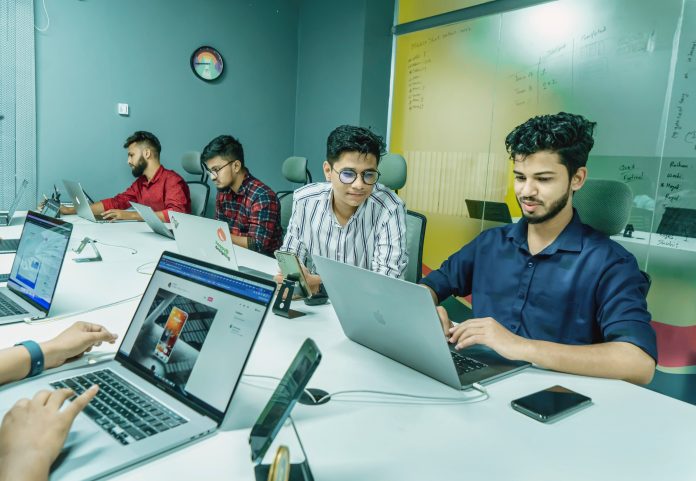By Ivan Cossu, Co-founder & CEO, deskbird
Fewer than five years ago, companies were often growing their office space to offer employees desirable space to work, shower, store bikes – even to socialise in. It was a given that colleagues came to the office every day. They worked at desks, often assigned but increasingly hot desks, collaborated in meeting rooms, and swapped stories in the kitchen.
Today it’s very different. People are often hybrid-working and are far less likely to be found in the office, to the chagrin of local service businesses, but also workers themselves, becoming atomised and lonely. Companies are still navigating the change, and those who want to be seen as modern employers need to genuinely adapt to new, flexible ways of working.
This flexibility applies to the place of work, the design of the office, working hours, and the technology and processes that tie it and everyone together. Organisations are looking for space efficiency and optimal office use to connect their people and give them a better experience – as well as to ensure their rents are worth it.
Redesigning offices, reducing space, and ensuring people can access these office assets and each other is a logistical challenge to jury-rig into a de facto hybrid working world. Here are tips on how organisations can be efficient, inspiring, and collaborative when making the office a desirable destination once again.
Don’t react – analyse
Assess workforce needs before taking a sledgehammer to the conference room walls. When looking to redesign a human space it’s important that all the people who use it get input into design and planning. If leaders want teams to mix, feel a sense of team, have space for collaboration and for ‘deep’ work, then bear in mind user expectations. For example, millennials often like to work together, Gen Zs are often used to greater independence.
The different business departments will have their own needs and expectations. For example, marketers need spaces for creative sessions. Developers and analysts need plenty of quiet to focus. Use surveys, workshops, or other mechanisms to ensure a redesign properly supports productive and happy teams.
Adapt space and assets to real needs
You can design the working environment so that employees have the right conditions for great work, plus socialisation helps make a thriving culture. Armed with the right data on desired use, work out:
- What tasks and activities employees perform when in the office: Work and social
- Which activities do they prefer to do elsewhere
- How teams collaborate in dedicated space, and how often
- How employees deal with quiet focus time
All of these points and more will offer a view on the space requirements and types necessary. This covers individual workstations, sitting or standing desks, meeting rooms, lounges, meal and quiet spaces, AV equipment, etc.
Get desk sharing right
Efficiency does not mean drastically reducing office space or offering as many desks as possible in a small space. Focus on the optimal space design so that employees feel comfortable, satisfied and continue to work productively.
Desk sharing allows efficiency with fewer desks. If the space around them is optimised for varied working practices, like open plan vs. quieter, private areas, different styles can be accommodated too. There are a range of other benefits. Colleagues encounter others from outside their teams and build or strengthen relationships and awareness of business practices.
It becomes a smooth process with workplace management solutions, making it easy to coordinate who works when and where. Employees don’t want to merely book desks and rooms; they need to organise themselves to work with the teams they need in the best places for their collaboration. Make it easy for colleagues to see where team members are and where they plan to work from. Take away the need for manual coordination with automation that can match teams together in productive ways.
Data analysis unearths insights
If people, teams, and office managers are to make more informed decisions, they need the data on how work is completed. Workplace management solutions offer analytical functions, so managers can check usage, make better forecasts on utilisation, and plan improvements to help their people make the most of each other, their time, and space. Businesses concerned with energy usage and costs can even close down areas when demand is lower, reducing cleaning and energy use.
Reinvest in your people and environment
It’s a very old-fashioned mindset just to expect people to make do with what they are given in a world of optimised technology, ergonomic furniture, and the option of working elsewhere if they are not offered flexibility.
Plan for and invest in the right mix of equipment, technology, and services so the business is desirable, productive, and fit for a mobile workforce who could work anywhere – but choose to be their most productive selves with you. Budget saved in areas like rent or furniture could drive further improvements in team building activities, well-being, or transformational tech.
Stay up-to-date
Stay alert, stay flexible. Seamless hybrid work has only become possible because of rapid technological change in the last decade. Redesigning the office and overall workplace is now a dynamic process as the needs of businesses and employees change. Check on the usage and satisfaction of your people. Can they do the work they need? Can they work with who they need, when they need, with the greatest productivity? Are they comfortable and content?
All these issues – people, places, assets, technology, processes, spaces – blend into the construct that is ‘work’. Balancing these needs in the name of productivity and efficiency means data, planning, and flexibility are vital. These factors all have an enormous impact on culture, enthusiasm, and retention – in fact, everything that feeds into profitability and must be planned for to succeed in what has become the digital, hybrid age.

